
The Sunshine State is famous for its citrus. You can barely turn around in Central Florida without catching sight of an orange grove or a stand selling local oranges. But oranges aren’t the only fruit game in our region!
Florida is home to a wide variety of fruit trees, both native and imported, that enjoy our sun, warm weather, and rich soil. Here are six Florida fruits to look out for on your next hike or farmer’s market run!
BUT, before reading, please remember: NEVER pick or consume any plant that you do not absolutely know is safe to eat. For as many tasty fruits as Florida has, it also has poisonous– even deadly– ones. The poisonous ones can even look like their non-poisonous counterparts. Use caution and consult a trusted authority when identifying edible plants.
Kumquats
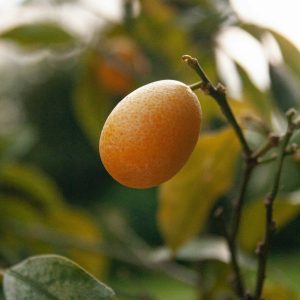 Native to China, where its name means “golden orange”, the kumquat is a small citrus fruit that tolerates the cooler winters of Central Florida very well and can be found throughout the region. Even though it’s the world’s smallest citrus fruit, the kumquat is full of flavor—it can be eaten whole, peel and all, and comes in tart and sweet varieties. The fruit is also famous for making delicious jams, jellies, and preserves. Kumquats are popular as ornamentals—the shrub-like trees resemble small orange trees with delicate, white, fragrant blossoms. Photo by Tina Xinia on Unsplash.
Native to China, where its name means “golden orange”, the kumquat is a small citrus fruit that tolerates the cooler winters of Central Florida very well and can be found throughout the region. Even though it’s the world’s smallest citrus fruit, the kumquat is full of flavor—it can be eaten whole, peel and all, and comes in tart and sweet varieties. The fruit is also famous for making delicious jams, jellies, and preserves. Kumquats are popular as ornamentals—the shrub-like trees resemble small orange trees with delicate, white, fragrant blossoms. Photo by Tina Xinia on Unsplash.
Loquats
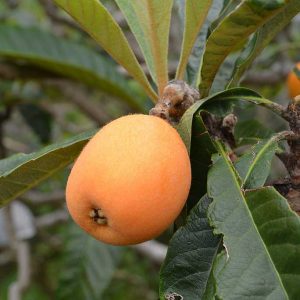 Another China native that thrives well in Central Florida, the loquat is an oval golden fruit with slightly fuzzy skin like a peach. Despite its name, the loquat isn’t related to the kumquat, but is closer to plums and pears. Like the kumquat, the whole fruit is edible and tastes like a mildly citrusy peach. The trees make striking ornamentals with their long, broad, dark leaves, and the fruits become ripe in very late winter and early spring. They can be eaten whole, preserved in syrup, made into jams and jellies, and used as pie filling. Photo by Katorisi / CC BY-SA.
Another China native that thrives well in Central Florida, the loquat is an oval golden fruit with slightly fuzzy skin like a peach. Despite its name, the loquat isn’t related to the kumquat, but is closer to plums and pears. Like the kumquat, the whole fruit is edible and tastes like a mildly citrusy peach. The trees make striking ornamentals with their long, broad, dark leaves, and the fruits become ripe in very late winter and early spring. They can be eaten whole, preserved in syrup, made into jams and jellies, and used as pie filling. Photo by Katorisi / CC BY-SA.
Muscadine Grapes
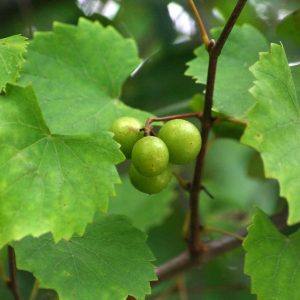 Florida has its very own native species of grape, and that is the muscadine grape. Unlike their smaller, sweeter, more delicate cousins, muscadines thrive in the summer heat. They’re also resistant to many blights that decimate other grape populations, such as Pierce’s disease, phylloxera, and a host of other insect pests. This makes them great candidates for wine-making, and many regional wineries include the muscadine in their blends. They’re also famous in the region for being used in jellies. You can usually find both the fruits and jellies at local farmer’s market, especially in early fall when the grapes are most ripe. The best way to eat them is to slip them out of their thick skin, which comes off easily, and eat the sweet-sour pulp. Photo by Pollinator / CC BY-SA.
Florida has its very own native species of grape, and that is the muscadine grape. Unlike their smaller, sweeter, more delicate cousins, muscadines thrive in the summer heat. They’re also resistant to many blights that decimate other grape populations, such as Pierce’s disease, phylloxera, and a host of other insect pests. This makes them great candidates for wine-making, and many regional wineries include the muscadine in their blends. They’re also famous in the region for being used in jellies. You can usually find both the fruits and jellies at local farmer’s market, especially in early fall when the grapes are most ripe. The best way to eat them is to slip them out of their thick skin, which comes off easily, and eat the sweet-sour pulp. Photo by Pollinator / CC BY-SA.
Chocolate Pudding Fruit (Black Sapote)
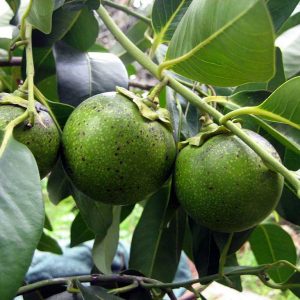 You’ll have to break out the spoons for this unique tropical fruit. A relative of the persimmon that’s made its way from Mexico to Central and South Florida, chocolate pudding fruit (aka black sapote) looks like a dark green tomato on the outside when ripe, and like, well, chocolate pudding on the inside. The creamy fruit is incredibly sweet and can be scooped out of the rind with a spoon after removing the seeds, or blended into smoothies for a unique sugary treat. Like all persimmons, the black sapote is best when extremely ripe and the skin indents easily. They can be very bitter otherwise! Photo by Yonygg.
You’ll have to break out the spoons for this unique tropical fruit. A relative of the persimmon that’s made its way from Mexico to Central and South Florida, chocolate pudding fruit (aka black sapote) looks like a dark green tomato on the outside when ripe, and like, well, chocolate pudding on the inside. The creamy fruit is incredibly sweet and can be scooped out of the rind with a spoon after removing the seeds, or blended into smoothies for a unique sugary treat. Like all persimmons, the black sapote is best when extremely ripe and the skin indents easily. They can be very bitter otherwise! Photo by Yonygg.
Mayhaws
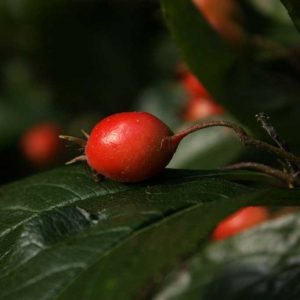 Known as Florida’s cranberry, you’d be hard-pressed to find a farmer’s market in Central or North Florida that doesn’t have at least a few jars of mayhaw jelly for sale. Mayhaw is considered a Southern delicacy, and several cities in Florida hold local mayhaw festivals in honor of the fruit. The mayhaw loves moist soil around creek and river bottoms, and gets its name from the time of year it is most ripe: May. The berries are extremely tart, which is why mayhaw jelly—spread thick on biscuits with lots of butter, please!—is a time-honored Florida tradition. The mouth-puckering mayhaw is very easy to turn into a sweet, lightly tart jelly that goes with almost anything. Photo by Leslie Seaton from Seattle, WA, USA / CC.
Known as Florida’s cranberry, you’d be hard-pressed to find a farmer’s market in Central or North Florida that doesn’t have at least a few jars of mayhaw jelly for sale. Mayhaw is considered a Southern delicacy, and several cities in Florida hold local mayhaw festivals in honor of the fruit. The mayhaw loves moist soil around creek and river bottoms, and gets its name from the time of year it is most ripe: May. The berries are extremely tart, which is why mayhaw jelly—spread thick on biscuits with lots of butter, please!—is a time-honored Florida tradition. The mouth-puckering mayhaw is very easy to turn into a sweet, lightly tart jelly that goes with almost anything. Photo by Leslie Seaton from Seattle, WA, USA / CC.
Chickasaw Plum
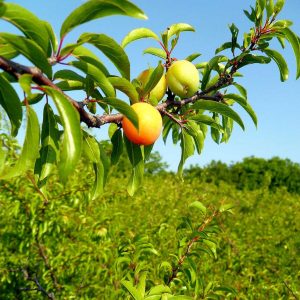 Also known as Cherokee plums or Florida sand plums, this tree is striking and dramatic when it flowers in early spring. It is instantly recognizable by its twiggy appearance and numerous clusters of white blossoms, which appear before the tree grows its leaves again in the spring. After the flowers appear the fruits begin to grow, ripening from red to yellow. The tree requires little maintenance, grows wild easily, and fruits before many other plants at the beginning of the year. The fruit of the tree tastes like a slightly tart plum, and is enjoyed both raw and in preserves. Photo by Lm13700 / CC BY-SA.
Also known as Cherokee plums or Florida sand plums, this tree is striking and dramatic when it flowers in early spring. It is instantly recognizable by its twiggy appearance and numerous clusters of white blossoms, which appear before the tree grows its leaves again in the spring. After the flowers appear the fruits begin to grow, ripening from red to yellow. The tree requires little maintenance, grows wild easily, and fruits before many other plants at the beginning of the year. The fruit of the tree tastes like a slightly tart plum, and is enjoyed both raw and in preserves. Photo by Lm13700 / CC BY-SA.
Want to know more about Florida fruits and agriculture? Contact our team! Many of us are deeply and personally involved in the regional agricultural industry and would love to answer your questions!
*NEVER pick or consume any plant that you do not absolutely know is safe to eat. For as many yummy fruits as Florida has, it also has poisonous—even deadly—ones. The poisonous ones can even look like the yummy ones! Use caution and consult a trusted authority when identifying edible plants.